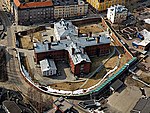Tervasaari
Islands of HelsinkiKruununhaka

Tervasaari (Swedish: Tjärholmen), meaning "tar island", is an island in Helsinki, Finland, in front of the district of Kruununhaka. Tervasaari is connected to the mainland by a long causeway called Tervasaarenkannas. The causeway is connected to the Pohjoisranta street on the eastern edge of the city centre.Facilities on the island include a granary restaurant, a children's play park, an area for dogs with a dog swimming place, an event venue and a pier for washing mats. Tervasaari was renovated into a functional island in the 1990s.
Excerpt from the Wikipedia article Tervasaari (License: CC BY-SA 3.0, Authors, Images).Tervasaari
Tervasaarenkannas, Helsinki Kruununhaka (Southern major district)
Geographical coordinates (GPS) Address Phone number Nearby Places Show on map
Geographical coordinates (GPS)
| Latitude | Longitude |
|---|---|
| N 60.173666666667 ° | E 24.9685 ° |
Address
Ravintola Savu
Tervasaarenkannas 3
00170 Helsinki, Kruununhaka (Southern major district)
Finland
Open on Google Maps









